![]()
![]()
![]()
Use LEFT and RIGHT arrow keys to navigate between flashcards;
Use UP and DOWN arrow keys to flip the card;
H to show hint;
A reads text to speech;
36 Cards in this Set
- Front
- Back
|
Types of Sedimentary Rocks
|
Clastic and Chemical
|
|
|
Clastic
|
Made up of CLASTS (grains = detritus) and CEMENT (calcite, quartz, or hematite).
Cementation due to DIAGENESIS |
|
|
Chemical
|
Made of chemical or evaporite sediments; most such rock made up of just one mineral species...
EX: Limestone, dolomite, evaporites |
|
|
Mechanical Weathering
|
Big to little particles -NO CHEMICAL CHANGE!
|
|
|
Chemical Weathering
|
Dissolution of minerals, or formation of new minerals that are more stable at the lower temperature, lower pressure, and higher moisture at the earth's surface.
|
|
|
Transportation for clastic rocks
|
Physically transported by wind, water currents, flowing glacier ice, and/or gravity.
|
|
|
Depositon for clastic rocks
|
Transportation energy is insufficient to move the particle.
As transportaion energy decreases, the larger (heavier) particles are deposited first. |
|
|
Transportation and Deposition for chemical sedimentary rocks
|
Sediments come from precipitation out of solution by biological activity, chemical changes, or evaporation.
|
|
|
Diagenesis
|
Changes that occur after deposition at low temperature and pressure that turn loose sediment into sedimentary rock.
|
|
|
Particle Size: Clay
|
Very fine-grained
|
|
|
Particle size: Silt
|
Fine-grained
|
|
|
Particle size: Sand
|
Medium-grained
|
|
|
Particle size: Gravel
|
Coarse-grained
|
|
|
Particle size indicates...
|
The energy of the transportine medium. the LARGER the size of grains in a clastic rock, the MORE ENERGY it takes to move that particle to the place of deposition.
|
|
|
Angularity: Well-rounded
|
All corners of a grain are rounded off
|
|
|
Angularity: Angular
|
All corners of a grain are still sharp (pointed).
|
|
|
What does angularity tell us?
|
The more the corners of an individual grain in a clastic rock are rounded, the longer the distance the grain has been transported.
|
|
|
Sorting: poorly sorted
|
Large and small grains jumbled together.
Poor sorting suggest that the particless have not been tranported very far. |
|
|
Sorting: well-sorted
|
All grains are the same size.
|
|
|
Sedimentary Structures: Stratification
|
Horizontal layhering at time of deposition
|
|
|
Sedimentary Structures: Ripple marks
|
Undulatory structures due to wind/water current
|
|
|
Sedimentary structures: Cross-bedding
|
Inclined layering withing a horizontal bed due to ripple mark rem-nants
|
|
|
Sedimentary Structures: Fossils
|
Evidence of past life
|
|
|
Sedimentary Structures: Mud cracks
|
When mud dries, it shrinks and pulls apart from itself, forming polygonal columns
|
|

|
Name: Arkose
Distinctive Features: Typically angular and coarse. may contain mica or other granitic consituents. Energy of Environment of Deposition: Near to granitic source rock, typically in alluvial fan or floodplain. |
|
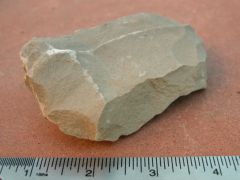
|
Name: Siltstone
Distinctive Features: Fine-grained rock with slightly gritty feel. Separates along bedding planes with difficulty. Energy of Environment of Deposition: Low- to moderate- energy aqueous environment: river, nearshore marine. may be wind-blown material. |
|
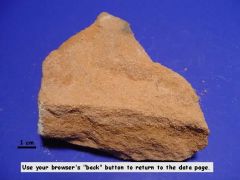
|
Name: Quartz Sandstone
Distincitive Features: Highly variable: rounded or angular quartz grains, with or without distinct stratification or sidimentary structures, lithified by cement with numerous possible colors. Energy of Environment of Deposition: beach or nearshore deposit, poin bar in river meander, certain alluvial plains. Sand dune or other wind-blown deposit |
|

|
Name: Conglomerate
Distinctive Features: Rounded grains up to boulder size (or larger), set in a matrix of finer material. Energy of Environment of Deposition: High-energy: tream bed subjet to violent flooding, steep slope whether above or below sea level. |
|
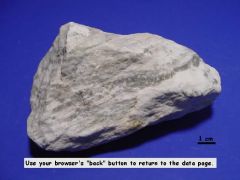
|
Name: Rock Gypsum
Distinctive Features: Can be scratched by fingernail. chiefly in compact granular masses. may exist as transparent slabs. |
|

|
Name: Breccia
Distincive Features: Similar to conglomerate, except that fragments are angular Energy of Environment of Deposition: LImited transport of fragments. |
|

|
Name: Rock Salt
Distincitve Features: Rock form halite. Normally a coarse crystalline aggregate. Colorless, or pale orange or rarely other colors. Environment of Deposition: Low-energy site of evaporation of natural waters: coastal marine or desert intermittent lakes. |
|

|
Name: Coal
Distinctive Features: Dark brown to black, low density. Commonly banded. May contain recognizable plant remains. Tendency to crumble. Environment of Deposition: Decomposed and altered remains of plants deposited in marshes, swamps, or estuaries. |
|
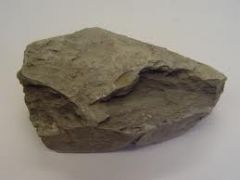
|
Name: Shale
Distincive Features: Smooth feel because particles are very small. Splits easily along closely-spaced bedding planes. Energy of Environment of Deposition: Low-energy aqueous environment: lake, continental shelf, lagoon, deep marine. |
|
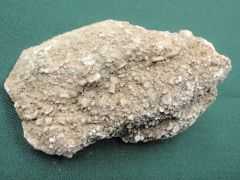
|
Name: Limestone
Distinctive Features: Reacts vigorously with cold dilute HCI. Typically light-colored. May have body fossils and trace fossils. Environment of Deposition: Evaporite; organic or inorganic precipitation in marine water (deep ocean floor, reef, lagoon, intertidal zone) or fresh water (cavern, hot spring). |
|
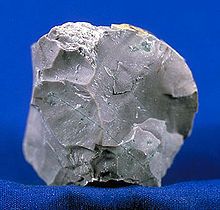
|
Name: Chert
Distinctive Features: Massive. Conchoidal fracture. Broken surfaces resemble unglazed porcelain. Environment of Deposition: Deep ocean ooze of microscopic siliceous shells of single-celled organisms. Inorganic precipitation from sea water. Replacement of pre-existing carbonate. |
|
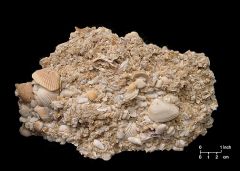
|
Name: Coquina
Distinctive Features: Shell fragments cemented with calcite. Environment of Deposition: Shallow high-energy marine setting with abundant shell-building organisms. |

